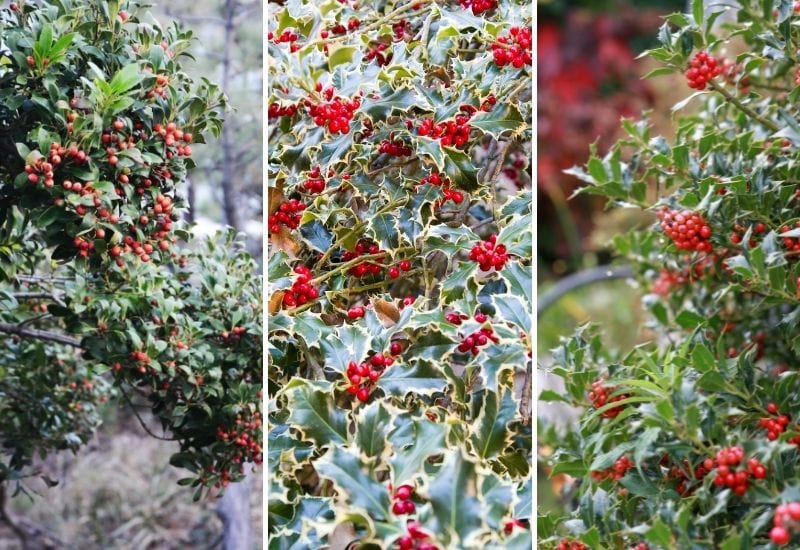
Holly is the “Christmas” plant par excellence with its famous spiked leaves and red berries. But did you know that holly is actually a genus of 480 different species of shrubs and trees called Ilex?
It is also a very “international” plant which includes large trees and small shrubs from all over the world.
Gardeners use it for foundation planting, for hedges, for borders, and even as individual trees or bushes. Last, but not least, if you thought that all hollies are evergreen, think again!
Of the 480 varieties of holly plants in the Ilex genus, 10 main varieties have made their way into general gardening; of these, some are evergreen while others are deciduous.
Holly blurs the divide between tree and shrub; they can be shrubby trees, or shrubs trained into trees, while some are actual full trees when adult.
Shrub, tree, shrubby tree, deciduous and evergreen… I get that you start feeling like you are lost in a maze of holly trees…
Don’t worry, I’ll help you pick the right holly species that suits your landscape. Let’s start together and I will show you how to recognize all the types of hollies used in gardening and also how to grow them and how to make the best of them in your garden!
Meet Holly, A Very Special Plant!
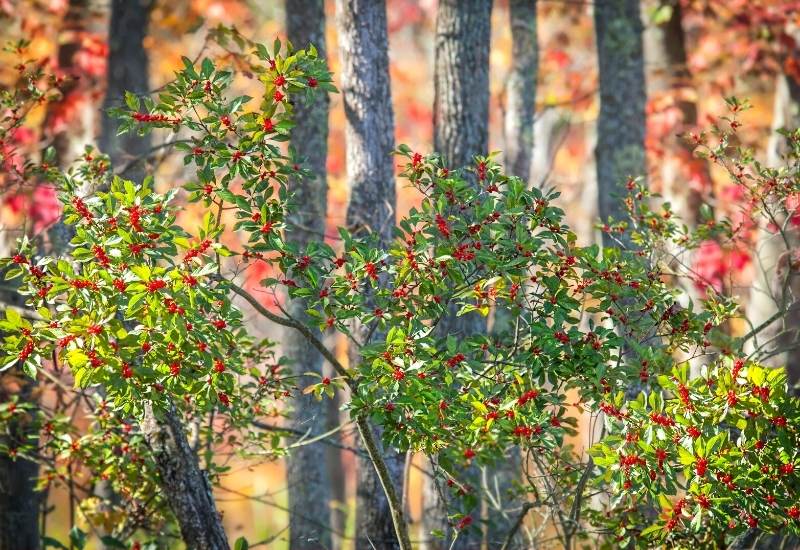
The genus Ilex, or holly as it is commonly known comes form many places all over the world. It can grow in temperate, tropical and subtropical regions alike, so may originate from Venezuela, Peru, Taiwan, the US and even Europe.
The most iconic species, English holly, or Ilex aquifolium, is a European species that found its way into the grand gardens of the nobility early on.
Because it has a very rich and glossy foliage, it is mainly used for hedges, wind barriers and for topiary. You will find it in Italianate gardens cut into all sorts of shapes. In fact it is ideal for this art. It has very hard trunk and branches, and it tolerates all sorts of cutting and pruning…
Most types of hollies are evergreen; again, this is good for topiary and hedges. The leaves are often spiked. But even here, holly is quite strange. Many varieties have spiked leaves at the bottom and not at the top. Guess why? Because they only need to protect themselves from munching herbivores lower down the plant! Clever, isn’t it?
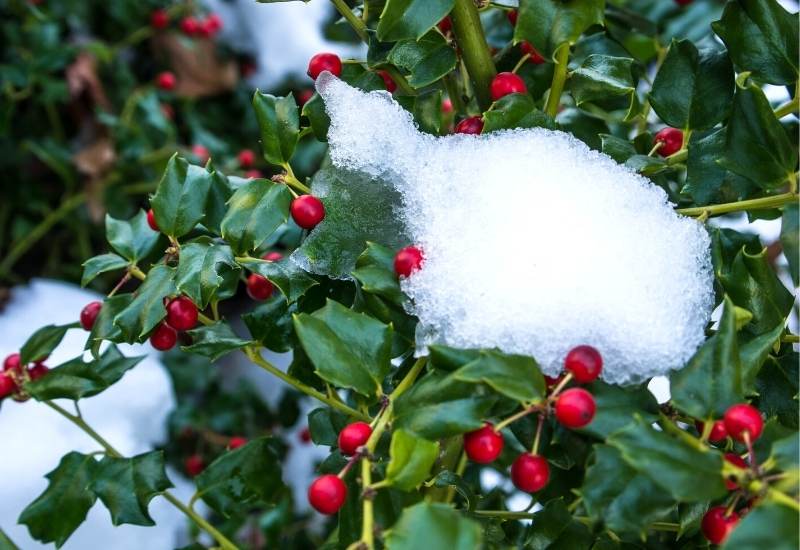
But for this very reason, hollies make excellent hedges against intruders, and they don’t need to worry about cattle or deer.
Holly berries are also slightly poisonous, so don’t eat them. On the plus side, not even goats eat holly leaves! And trust me, all gardeners know that if a goat does not eat it, no other mammal will!
The flowers are not conspicuous, but the beautiful berries are make great decoration on the deep green leaves in fall and winter!
The main distinction you need to know is if your chosen holly variety is evergreen or deciduous. This is because they will have different functions. You can’t use deciduous plants for topiary, for example. The effect in winter is not the same, of course. So, this is the main thing you want to know as a gardener…
Finally, the bush / tree divide… Ok, most hollies are classed as trees. The fact is that they are “bushy” in appearance, and young or small specimens can be treated as shrubs for gardening purposes. As usual, botany and gardening don’t always match with definitions!
How to Tell Berry Bearing Holly Shrubs and Trees Apart
Let’s look at the key things to look out for in order to recognize a holly tree form another. There are some basic characteristics you wish to keep in mind. And here they are.
So now you are ready to start looking at each of the holly varieties in turn. You will learn how to recognize each one, but also how to make sure it is healthy and that it looks great in your garden or on your terrace.
10 Holly Plant Varieties To Give Your Garden Year Round Interest
Here are the 10 most popular holly varieties, trees and shrubs, tall and short, but all beautiful and well tested by gardeners, divided between evergreens and deciduous varieties:
Evergreen Holly Varieties
Most garden holly varieties are evergreen. It’s not surprising given the fact that Ilex is a used on Christmas cards and it is almost synonymous with winter itself.
An evergreen variety is of course ideal for a hedge that keeps green all year round. But also as foundation plants, they can keep the green theme through the cold season, a bit like conifers do. You don’t want your garden to loom completely barren in winter!
So, here are the main evergreen holly varieties you can grow in your garden, and some are small enough for container planting as well!
1. English Holly (Ilex aquifolium)
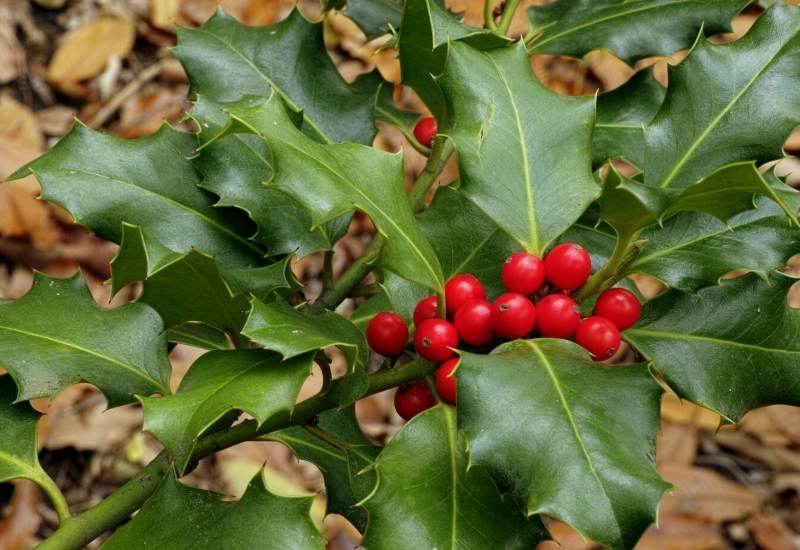
English holly is the classic of classics when it comes to our genus of winter trees! It is the postcard variety. It has glossy, hard to the touch foliage which is spiky at the bottom and smooth edged at the top.
The leaves are if a deep dark emerald green color, but there are some variegated varieties. For example, the striking ‘Argentea’ cultivar has cream yellow edges to the foliage and the twigs are purple! ‘Argentea’ has won the Award of Garden Merit by the Royal Horticultural Society. The trees naturally have an upright habit with conical shape.
The red berries of this evergreen variety will liven up your winter garden where you can use it as a specimen tree or for foundation planting, given its large size.
2. Chinese Holly (Ilex cornuta)
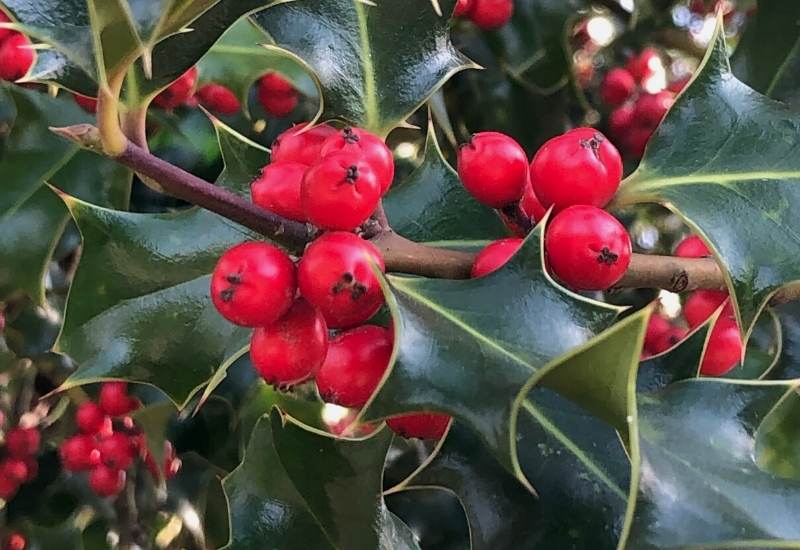
Chinese holly is a lovely but evergreen busy variety. The leaves are elliptic and of a rich emerald green color, but with no spikes.
They have a leathery texture and they are slightly twisted. The white flowers come in spring and they are small, but very fragrant. Then, the red berries follow and they will stay on the pyramidal holly till fall or even winter.
This easy to grow evergreen variety that can be kept as a bush or allowed to grow into a tree.
This makes it suitable for hedges as well as foundation planting, as specimen gardens and it is adaptable to coastal gardens.
3. Japanese Holly (Ilex crenata)
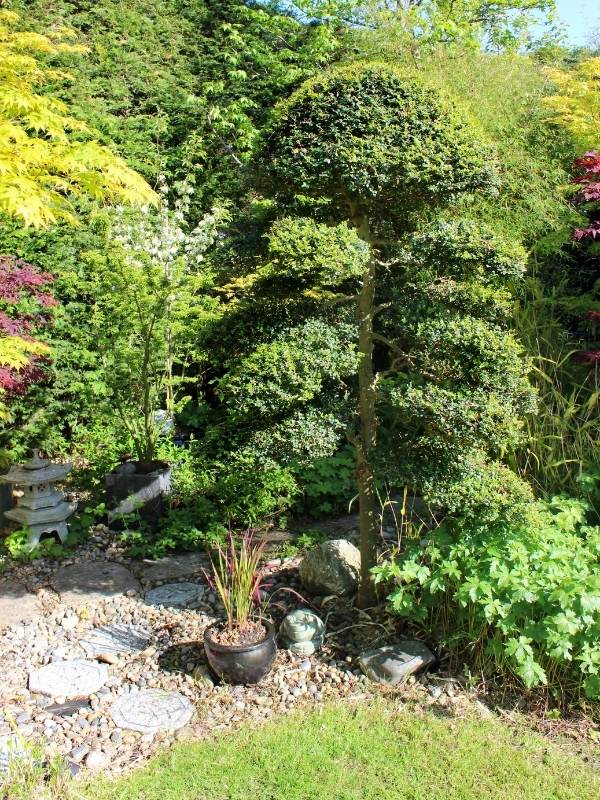
Japanese holly is a very original evergreen variety. The leaves are small, rounded and shiny, with wavy edges. The plant can grow in different shapes and with different habits. It can be thick and bushy or it can turn into an upright tree.
It is very easy to prune and train, so you can keep it small or give it any shape you wish. The berries are black (dark blue) and they appear in summer and ripen in fall.
Japanese holly is a good alternative to boxwood in hedged and foundation planting, also because it is hardier.
4. Japanese Holly ‘Sky Pencil’ (Ilex crenata ‘Sky Pencil’)
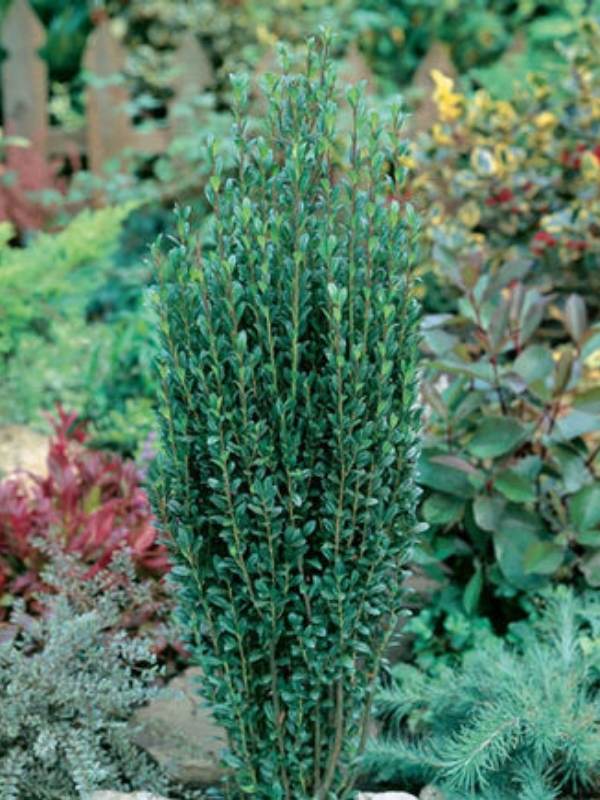
‘Sky Pencil’ is an original looking evergreen variety of Japanese holly. The name is a clue; it grows into tall and narrow columns, or plumes. The overall shape is that of a poplar tree, but it’s smaller. The habit is very particular and unusual for hollies.
The leaves are green and shiny, small and without spikes. Then, the berries come in summer and they turn black and ripe in fall.
Japanese Holly ‘Sky Pencil’ is a decorative and unusual variety; grow it as a specimen plant or in small groups of spaced out “pencils”; it is also ideal for wall side borders. It is suitable for informal and urban gardens.
5. Japanese Holly ‘Brass Buckle’ (Ilex crenata ‘Brass Buckle’)
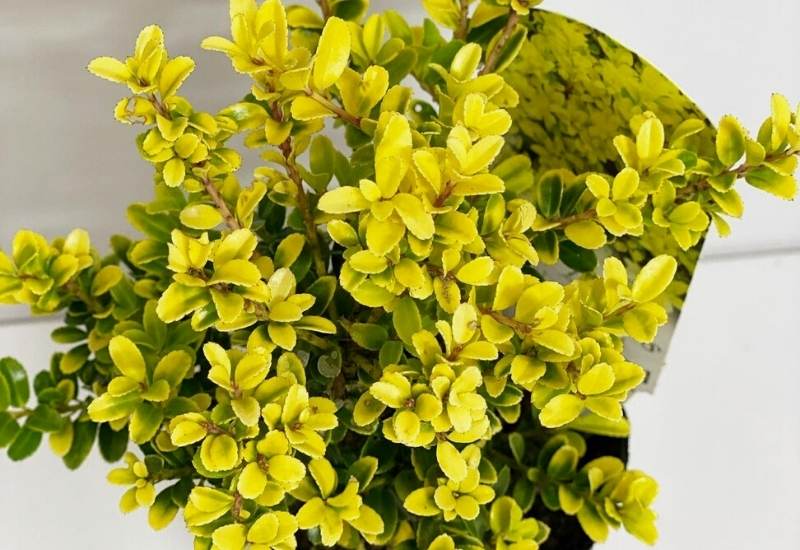
Japanese holly ‘Brass Buckle’ is not actually an evergreen: it’s an ever gold! The small oval foliage is in fact of a clear yellow shade, and it stays like this all year round!
It is a small shrub with a round habit, and its main feature is in fact the color of its foliage. Unlike other holly varieties, it is quite vulnerable to pests like aphids and scale insects.
This lovely little cultivar looks great on the sides of paths and it is small enough to grow it in containers. So, you can either mix it win with other shrubs to give some vibrant light to your borders or even grow it on your terrace, to have a bit of sunlight all year round!
6. American Holly (Ilex opaca)
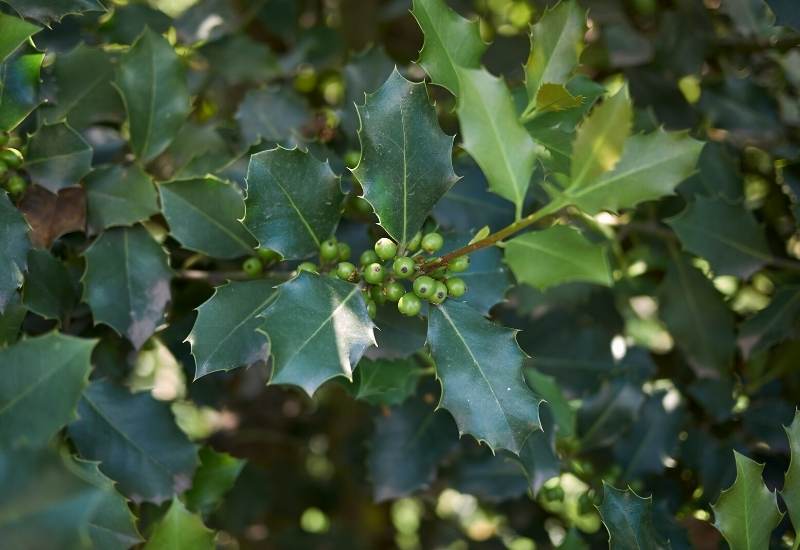
American holly is a very elegant evergreen tree with green, glossy teethed leaves and with clusters of red berries towards the tips of the branches. It has a very upright and pyramidal habit, and for this reason it is very sculptural.
The flowers are male and female, small and abundant and they come in spring. Then, the berries appear in summer and ripen in the fall.
It is an excellent plant for a large garden, even a stately one, or for urban parks. Grow it as foundation planting or as a specimen plant. It looks fantastic in small groups in focal positions.
7. Yaupon (Ilex vomitoria)
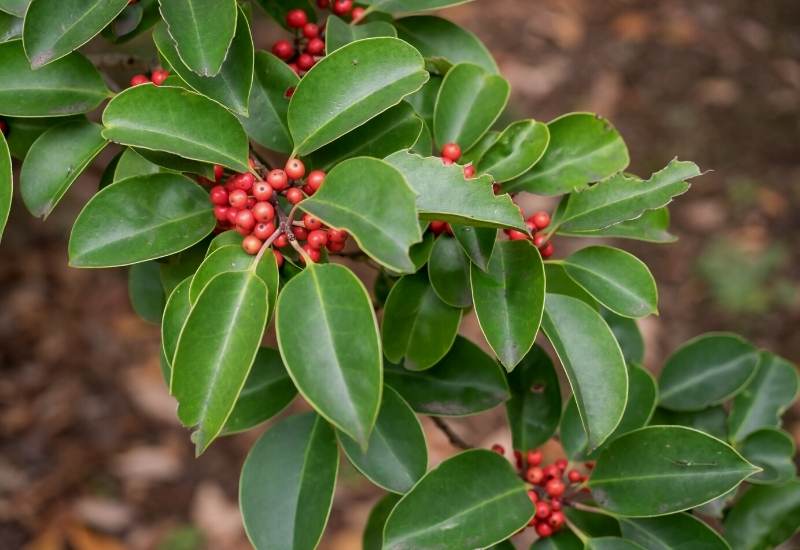
Yaoupon is yet another evergreen type of holly that can be both a shrub or a small to medium sized tree. It has very thick branches covered in equally thick glossy and leathery foliage. The leaves are elongated with shallow toothed edges.
The berries which appear in summer are plenty and bright red in color. The Latin name comes from the fact that its twigs contains caffeine and Native Americans used to eat them ceremonially and then vomit them back out…
How you use yaoupon will depend on whether you keep it as a shrub or tree. It is excellent for topiary, hedges and wind break as shrub, but as a tree you may even grow it in groups or as sample trees.
8. Inkberry ‘Shamrock’ (Ilex glabra ‘Shamrock’)
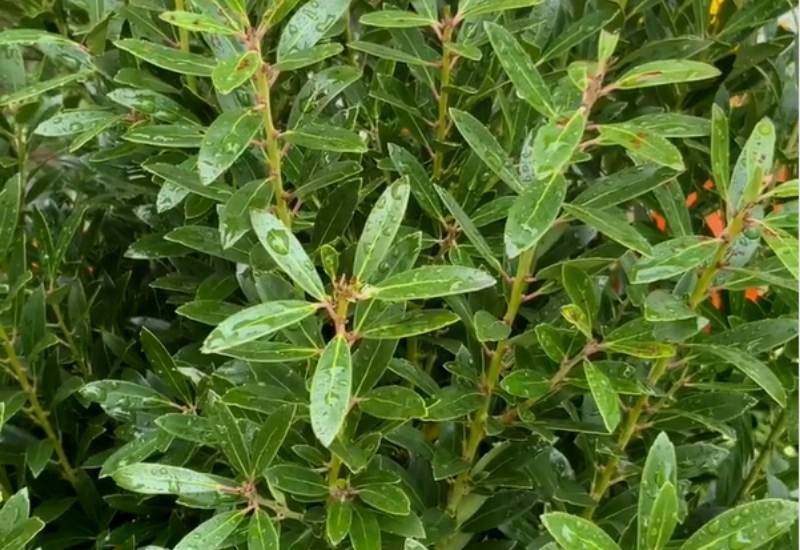
Inkberry is an evergreen shrub variety of holly, and the cultivar ‘Shamrock’ is one of the most popular.
It forms round and thick bushes filled with emerald green leaves and with a compact habit. The leaves are elongated, glossy, oval and without teeth or spikes.
The flowers come in summer and they are white green. They are small but abundant and they are followed by dark blue berries that will last till winter, birds permitting.
Inkberry ‘Shamrock’ is excellent in hedges and borders, but it is unusual as a holly for one reason… it loves water and wet soil. So you can use it for bog gardens, near ponds, wet gardens and along streams and rivers.
Deciduous Holly Plant Varieties
Evergreen hollies are more famous and even more common than deciduous trees and shrubs in the Ilex genus.
But there are two main leaf dropping species that are quite popular with gardeners: possumhaw and in particular winterberry.
These will drop their leaves at the end of fall but they will keep their berries on!
So the effect is different from what you get with evergreens, but still striking! Just imagine lots of colorful berries on thin barren branches all through the winter months…
So, shall we check them out as well? Here they are…
9. Possumhaw (Ilex decidua)
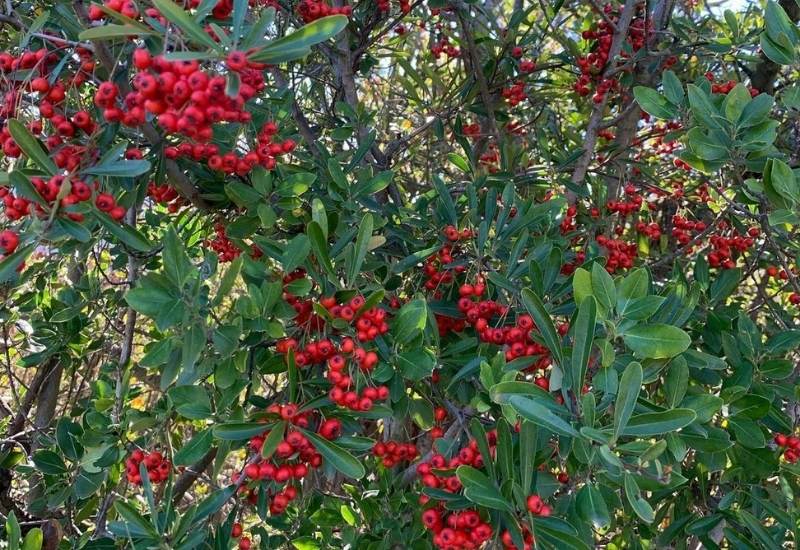
The scientific name of possumhaw literally means “deciduous holly”. The leaves of this shrub species are oval and fresh looking, herbaceous rather than glossy. They are of a light green shade and they are crenated at the margins.
These will turn yellow and drop in the fall, revealing a constellation of bright red berries on the slender branches of the plant that will last through the winter months. Pink, gold and blue varieties are also available.
Possumhaw is a very decorative shrub to grow in hedges or tall borders to keep them vibrant during the cold months. It will also adapt to stream and pond sides.
10. Winterberry (Ilex verticillata)
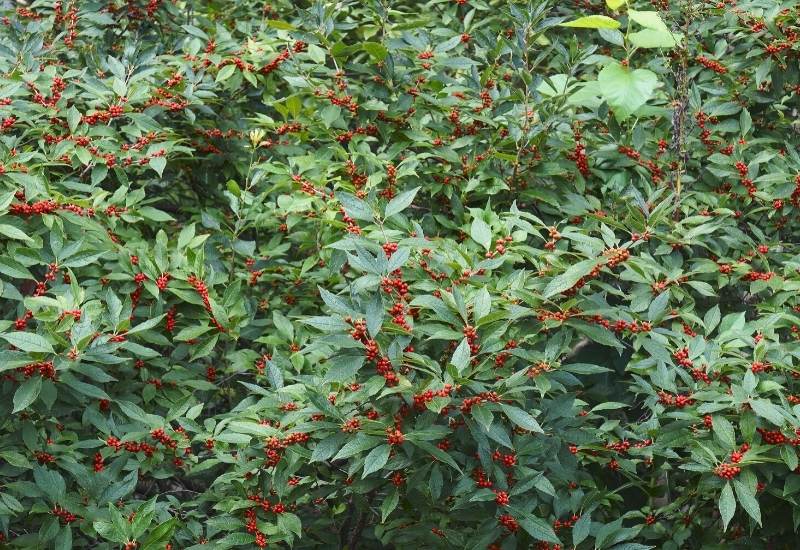
Winterberry transforms its being a deciduous holly shrub into a spectacle. The fact is that tender looking elliptical green leaves with serrated margins drop in fall is not a disadvantage…
This holly species in fact produces so many berries that you can hardly see branches they grow them on! These will last all fall and winter and in spring, your winteberry will blossom again…
There are many cultivars, each distinguished by the color if the berries, so, for your choice…
- ‘Red Sprite’ has crimson red berries.
- ‘Winter Gold’ has orange berries.
- ‘Berry Heavy Gold’ has yellow berries.
This Cary Award cold hardy Winner is great for borders and hedges, but it also looks great along rivers and by the side of a pond, and this variety too will grow well in wet and bog gardens!
Holly Varieties: More Than Just A Christmas Decoration
You see? There’s more to holly trees and shrubs than a small branch with spiky leaves and red berries to hang on your door at Christmas.
In fact hollies are great garden plants. Few plants have the qualities that we get from the Ilex genus…
Upright and straight trunks, conical and pyramidal shapes… you also get amazing glossy and decorative foliage.. add the fact that many can stand any type of cutting and shaping…
And then, of course, there are all those beautiful berries!
And now you you know all the most common garden varieties well, and you know where to grow them and how to use them, go ahead, start choosing the one that your garden or patio really needs!

Written By
Amber Noyes
Amber Noyes was born and raised in a suburban California town, San Mateo. She holds a master’s degree in horticulture from the University of California as well as a BS in Biology from the University of San Francisco. With experience working on an organic farm, water conservation research, farmers’ markets, and plant nursery, she understands what makes plants thrive and how we can better understand the connection between microclimate and plant health. When she’s not on the land, Amber loves informing people of new ideas/things related to gardening, especially organic gardening, houseplants, and growing plants in a small space.
